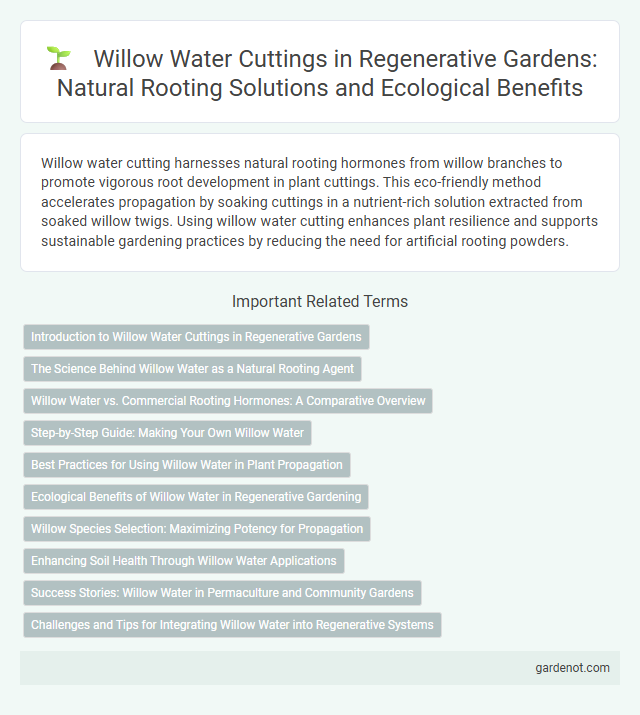Willow water cutting harnesses natural rooting hormones from willow branches to promote vigorous root development in plant cuttings. This eco-friendly method accelerates propagation by soaking cuttings in a nutrient-rich solution extracted from soaked willow twigs. Using willow water cutting enhances plant resilience and supports sustainable gardening practices by reducing the need for artificial rooting powders.
Introduction to Willow Water Cuttings in Regenerative Gardens
Willow water cuttings harness natural rooting hormones found in willow branches to promote robust plant growth and root development in regenerative gardens. Soaking willow branches in water releases auxins, which stimulate root formation in new plant cuttings, enhancing propagation success rates. This sustainable practice reduces the need for synthetic rooting agents, aligning with ecological gardening principles to support soil health and biodiversity.
The Science Behind Willow Water as a Natural Rooting Agent
Willow water contains high concentrations of indolebutyric acid (IBA) and salicylic acid, which stimulate root development and enhance plant growth. These phytohormones promote cell division and root elongation, making willow water an effective natural rooting agent for cuttings. Studies show that using willow water reduces rooting time and increases success rates in regenerative gardening practices.
Willow Water vs. Commercial Rooting Hormones: A Comparative Overview
Willow water, derived from young willow branches rich in indolebutyric acid (IBA) and salicylic acid, serves as an organic rooting stimulant in regenerative gardening, promoting root initiation and plant vigor naturally. Commercial rooting hormones typically contain synthetic auxins like IBA or naphthaleneacetic acid (NAA), offering consistent concentration and faster rooting results but with potential environmental impacts. Choosing willow water supports sustainable practices by reducing chemical use and enhancing soil health, while commercial products deliver standardized efficacy for propagation efficiency.
Step-by-Step Guide: Making Your Own Willow Water
Harvest young willow branches rich in natural rooting hormones such as indolebutyric acid by cutting 10-15 green shoots about 1-2 feet long. Submerge the chopped willow cuttings in a container of water, ideally rainwater or filtered water, and let them steep for 48 to 72 hours to extract the beneficial compounds. Strain the willow water and use it immediately or store it in a sealed container for up to one week to promote root growth in plant cuttings effectively.
Best Practices for Using Willow Water in Plant Propagation
Willow water, rich in natural rooting hormones like indolebutyric acid (IBA), enhances plant propagation by promoting faster root development and reducing transplant shock. Best practices include using young, green willow branches soaked in water for 24-48 hours to extract rooting compounds and applying the solution directly to cuttings or seedlings. Ensuring clean tools and fresh willow water for each use maximizes effectiveness and prevents contamination during propagation.
Ecological Benefits of Willow Water in Regenerative Gardening
Willow water, extracted from willow cuttings, is rich in natural rooting hormones like indolebutyric acid and salicylic acid, which enhance plant root development and resilience without synthetic chemicals. Its ecological benefits in regenerative gardening include promoting soil health by encouraging beneficial microbial activity and reducing the need for chemical fertilizers and pesticides. Using willow water cutting supports sustainable practices by fostering biodiversity and improving plant vigor in a natural, eco-friendly way.
Willow Species Selection: Maximizing Potency for Propagation
Selecting the optimal willow species for willow water cutting directly impacts the concentration of natural rooting hormones, primarily indolebutyric acid (IBA), enhancing propagation success. Salix alba and Salix babylonica are prominent species known for high auxin content, making them preferable choices for maximizing the potency of willow water. Targeting mature, healthy branches from these species ensures a richer hormone extract that promotes robust root development in plant cuttings.
Enhancing Soil Health Through Willow Water Applications
Willow water contains natural rooting hormones like indolebutyric acid and salicylic acid that stimulate microbial activity and root development, improving soil structure and nutrient cycling. Regular applications promote beneficial soil microorganisms, enhancing organic matter decomposition and increasing soil fertility in regenerative gardens. This natural bio-stimulant supports sustainable soil health by reducing the need for chemical fertilizers and boosting plant resilience.
Success Stories: Willow Water in Permaculture and Community Gardens
Willow water, a natural rooting hormone extracted from willow tree cuttings, has transformed permaculture and community gardens by enhancing plant propagation success rates. Gardens that employed willow water reported faster root development and stronger seedlings, leading to more resilient and productive green spaces. This sustainable technique has empowered local gardeners to regenerate biodiversity while reducing reliance on synthetic chemicals.
Challenges and Tips for Integrating Willow Water into Regenerative Systems
Willow water cutting faces challenges such as inconsistent hormone concentrations and susceptibility to contamination, impacting rooting success in regenerative gardens. To ensure effective integration, use fresh willow cuttings soaked for 24-48 hours in water, maintain clean containers, and apply the solution immediately to promote natural rooting hormones. Monitoring environmental conditions like temperature and moisture enhances the efficacy of willow water, supporting sustainable plant propagation within regenerative systems.
Willow water cutting Infographic

 gardenot.com
gardenot.com